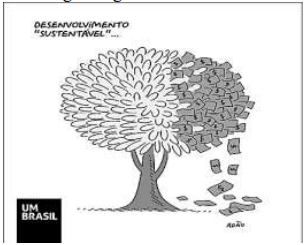Questões de Concurso
Para professor - inglês
Foram encontradas 18.316 questões
Resolva questões gratuitamente!
Junte-se a mais de 4 milhões de concurseiros!
Analise a imagem a seguir:

Fonte: https://g1.globo.com/ba/bahia/noticia/2024/07/10/duroatribulado-e-boca-de-me-de-apos-estreia-de-divertida-mente-2- baianos-fazem-memes-com-nomes-das-emocoes-emsalvador.ghtml
A imagem acima apresenta uma releitura dos
personagens do filme DivertidaMente 2, utilizando expressões do dialeto baiano para nomear as emoções
representadas. “Tristeza” é traduzido como “Duro(a);
“Alegria”, como “Gaiatice”; “Ansiedade”, como
“Atribulado”; e “Medo”, como “Vendo bicho”.
Considerando o contexto sociocultural e linguístico em análise, julgue as seguintes sentenças:
I- A substituição de “Tristeza” por “Duro(a)” e “Medo” por “Vendo Bicho” exemplifica o uso de gírias e expressões regionais, que conferem um caráter coloquial e identitário à linguagem.
II- A tradução de “Alegria” por “Gaiatice” e “Ansiedade” por “Atribulado” revela a criatividade e a expressividade do dialeto baiano, que utiliza recursos linguísticos próprios para transmitir emoções e sentimentos.
III- A adaptação dos nomes das emoções para o dialeto baiano reforça a ideia de que a norma culta da língua portuguesa é a única forma correta e válida de comunicação, sendo as demais variantes consideradas inferiores ou inadequadas.
IV- A imagem evidencia a importância da variação linguística como forma de expressão cultural e identitária, promovendo a valorização da diversidade e o reconhecimento das diferentes formas de falar o português no Brasil.
Estão CORRETAS:
Analise a charge a seguir:

- Desenvolvimento “sustentável”...
Adão
Fonte: https://umbrasil.com/charges/charge-01-02-2021/
A partir da charge, em que consta uma árvore com metade da copa feita de folhas e a outra metade feita de notas de dinheiro, intitulada “desenvolvimento ‘sustentável’”, assinale a alternativa que apresenta a interpretação CORRETA.
Considerando o contexto do relatório, analise as sentenças abaixo:
I- O uso do verbo “esperamos” denota uma postura passiva e resignada diante da escassez de mão de obra, como se fosse um fenômeno inevitável e incontrolável.
II- A escolha do verbo “esperamos” revela uma preocupação com o futuro do mercado de trabalho e a necessidade de se preparar para os desafios da escassez de mão de obra.
III- O verbo “esperamos” pode ser interpretado como um eufemismo para evitar o uso de termos mais alarmantes, como “prevemos” ou “tememos”, que poderiam gerar pânico ou desconfiança.
IV- A utilização do verbo “esperamos” reforça a ideia de que a escassez de mão de obra é um problema complexo e multifacetado, com causas e consequências que exigem análise e planejamento cuidadosos.
Estão CORRETAS:
“À medida que os países buscam mais fontes de energia renovável, as funções, incluindo engenheiros de energia renovável e engenheiros de sistemas e instalação de energia solar, estarão em alta demanda.”.
“Espera-se que os efeitos mais fortes de criação líquida de empregos sejam impulsionados por investimentos que facilitem a transição verde das empresas”.
1. (__) É garantido a igualdade de oportunidade a todo cidadão brasileiro, independente da cor da pele, de gênero e orientação sexual na construção de um espaço e diálogo e formação permanente entre escola, comunidade e Secretaria Municipal de Educação.
2. (__) Rede Municipal de Educação, através de seus órgãos competentes, promoverá a interdisciplinaridade com o conjunto das áreas humanas, exatas e biológicas, adequando o estudo da cultura afro-brasileira e africana, relação de gênero, orientação sexual e bullying, bem como, seus valores civilizatórios.
3. (__) Os conteúdos de gênero e orientação sexual serão norteados por meio das abordagens especificadas pela Secretaria Especial de Política para as Mulheres e da Secretaria de Direitos Humanos do Governo Federal, entre outros estudos especializados selecionados por grupo de trabalho.
A sequência CORRETA é:
1. (__) Durante o período imperial, o ensino de línguas estrangeiras no Brasil estava mais voltado para o francês e o latim, línguas consideradas prestigiadas nas elites intelectuais da época. A influência do francês era evidente na cultura e nas ciências, sendo a língua internacional da diplomacia e das artes.
2. (__) A partir da Era Vargas, com a industrialização e modernização do Brasil, o inglês começou a ocupar um lugar de destaque, principalmente no campo econômico e tecnológico. O aumento das relações comerciais com os Estados Unidos, que se tornaram um dos principais parceiros econômicos do Brasil, demandou o aprendizado do inglês como uma necessidade prática para profissionais ligados ao comércio, à indústria e ao governo.
3. (__) O período após a Guerra do Paraguai marcou uma expansão do ensino de inglês no Brasil. Com a hegemonia da Inglaterra na ordem mundial, o inglês se consolidou como a língua da ciência, da tecnologia e da política global.
A sequência CORRETA é:
"A Delta refutou as acusações levantadas em redes sociais ao dizer que a queima havia sido feita em maio no interior de Minas Gerais, reforçou que a prática está prevista em lei e que toma medidas contra a propagação de incêndios nas plantações de cana."
Em relação à concordância verbal/nominal, substituindo "a queima" por "as queimadas", a oração destacada ficará: